inflation pressure MITSUBISHI L200 2018 Owner's Manual (in English)
[x] Cancel search | Manufacturer: MITSUBISHI, Model Year: 2018, Model line: L200, Model: MITSUBISHI L200 2018Pages: 466, PDF Size: 28.42 MB
Page 2 of 466
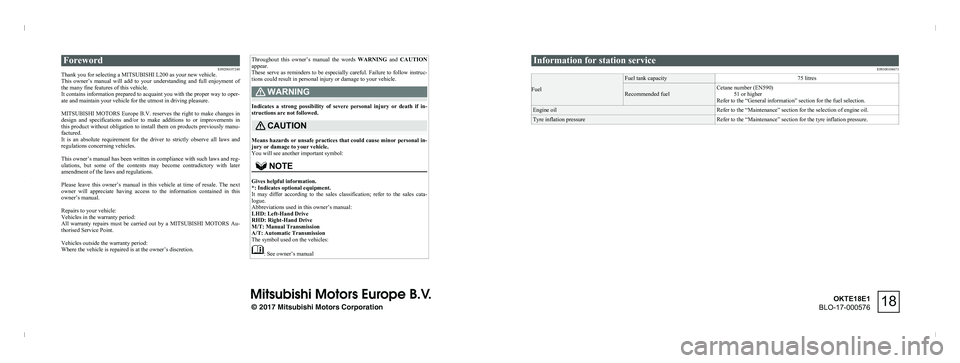
ForewordE09200107240
Thank you for selecting a MITSUBISHI L200 as your new vehicle.
This owner’s manual will add to your understanding and full enjoyment of
the many fine features of this vehicle.
It contains information prepared to acquaint you with the proper way to oper-
ate and maintain your vehicle for the utmost in driving pleasure.
MITSUBISHI MOTORS Europe B.V. reserves the right to make changes in
design and specifications and/or to make additions to or improvements in
this product without obligation to install them on products previously manu- factured.
It is an absolute requirement for the driver to strictly observe all laws and
regulations concerning vehicles.
This owner’s manual has been written in compliance with such laws and reg- ulations, but some of the contents may become contradictory with later amendment of the laws and regulations.
Please leave this owner’s manual in this vehicle at time of resale. The next
owner will appreciate having access to the information contained in this
owner’s manual.
Repairs to your vehicle:
Vehicles in the warranty period:
All warranty repairs must be carried out by a MITSUBISHI MOTORS Au-
thorised Service Point.
Vehicles outside the warranty period:
Where the vehicle is repaired is at the owner’s discretion.
Throughout this owner’s manual the words WARNING and CAUTION
appear.
These serve as reminders to be especially careful. Failure to follow instruc-
tions could result in personal injury or damage to your vehicle.WARNING
Indicates a strong possibility of severe personal injury or death if in-
structions are not followed.
CAUTION
Means hazards or unsafe practices that could cause minor personal in- jury or damage to your vehicle.
You will see another important symbol:
NOTE
Gives helpful information.
*: Indicates optional equipment.
It may differ according to the sales classification; refer to the sales cata- logue.
Abbreviations used in this owner’s manual: LHD: Left-Hand Drive
RHD: Right-Hand Drive
M/T: Manual Transmission
A/T: Automatic Transmission
The symbol used on the vehicles:
: See owner’s manual
Information for station service
E09300104673
Fuel
Fuel tank capacity75 litresRecommended fuelCetane number (EN590)51 or higher
Refer to the “General information” section for the fuel selection.Engine oilRefer to the “Maintenance” section for the selection of engine oil.Tyre inflation pressureRefer to the “Maintenance” section for the tyre inflation pressure.
© 2017 Mitsubishi Motors Corporation18
OKTE18E1
BLO-17-000576
Page 14 of 466
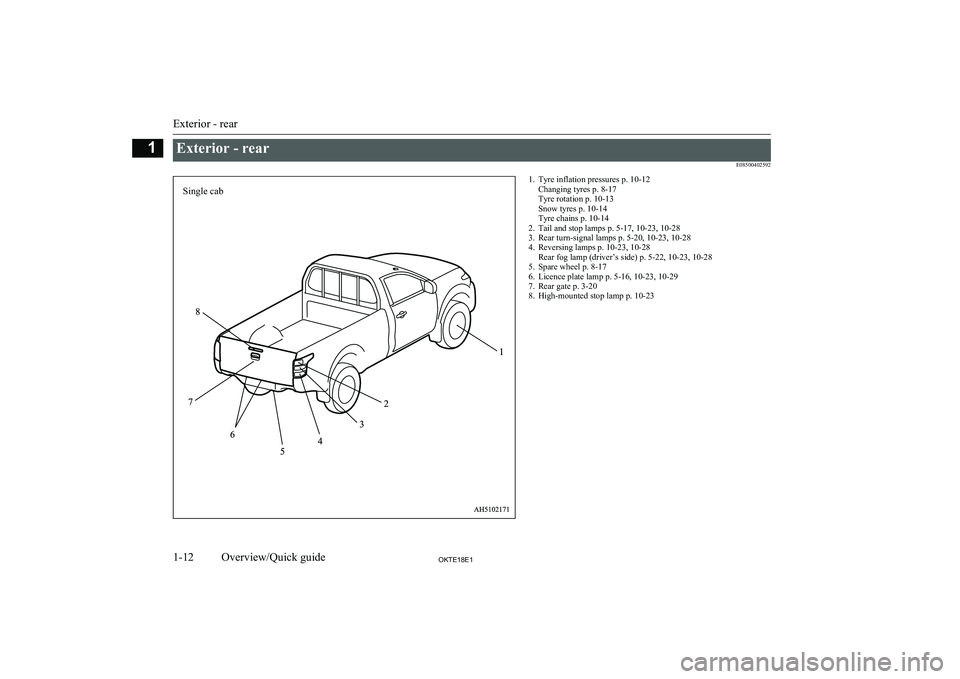
Exterior - rearE085004025921. Tyre inflation pressures p. 10-12Changing tyres p. 8-17
Tyre rotation p. 10-13
Snow tyres p. 10-14
Tyre chains p. 10-14
2. Tail and stop lamps p. 5-17, 10-23, 10-28
3. Rear turn-signal lamps p. 5-20, 10-23, 10-28
4. Reversing lamps p. 10-23, 10-28 Rear fog lamp (driver’s side) p. 5-22, 10-23, 10-28
5. Spare wheel p. 8-17
6. Licence plate lamp p. 5-16, 10-23, 10-29
7. Rear gate p. 3-20
8. High-mounted stop lamp p. 10-23
Exterior - rear
1-12OKTE18E1Overview/Quick guide1Single cab
Page 15 of 466
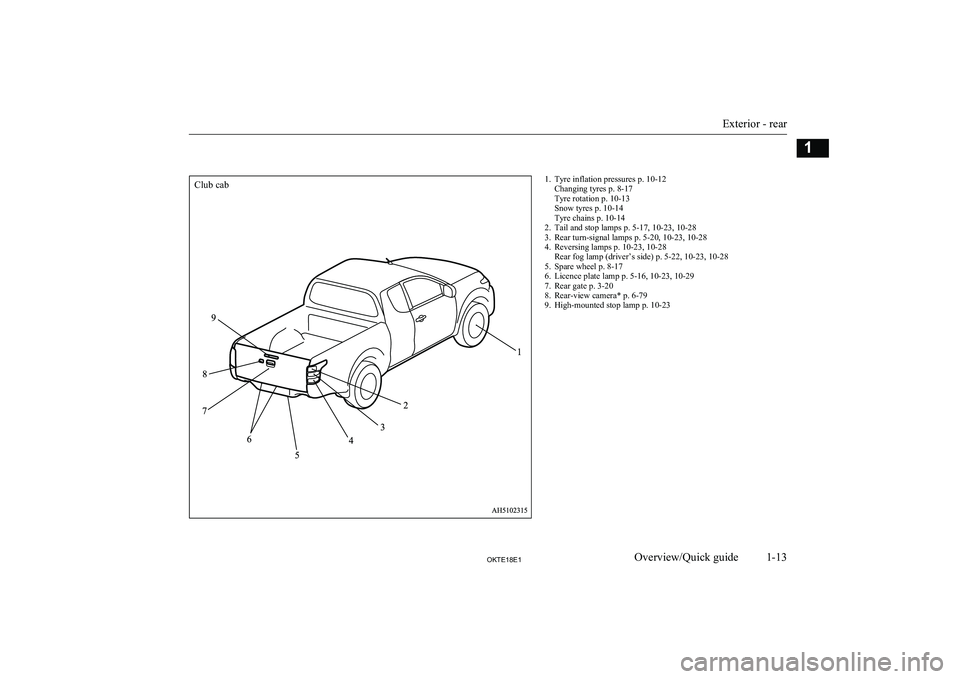
1. Tyre inflation pressures p. 10-12Changing tyres p. 8-17
Tyre rotation p. 10-13
Snow tyres p. 10-14
Tyre chains p. 10-14
2. Tail and stop lamps p. 5-17, 10-23, 10-28
3. Rear turn-signal lamps p. 5-20, 10-23, 10-28
4. Reversing lamps p. 10-23, 10-28 Rear fog lamp (driver’s side) p. 5-22, 10-23, 10-28
5. Spare wheel p. 8-17
6. Licence plate lamp p. 5-16, 10-23, 10-29
7. Rear gate p. 3-20
8. Rear-view camera* p. 6-79
9. High-mounted stop lamp p. 10-23
Exterior - rear
1-13OKTE18E1Overview/Quick guide1Club cab
Page 16 of 466
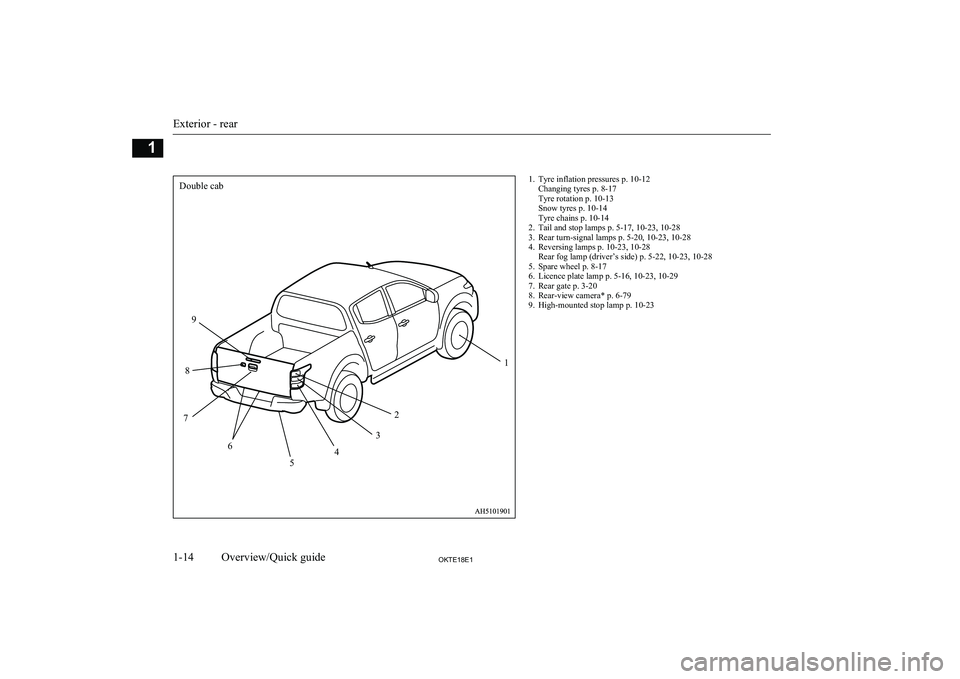
1. Tyre inflation pressures p. 10-12Changing tyres p. 8-17
Tyre rotation p. 10-13
Snow tyres p. 10-14
Tyre chains p. 10-14
2. Tail and stop lamps p. 5-17, 10-23, 10-28
3. Rear turn-signal lamps p. 5-20, 10-23, 10-28
4. Reversing lamps p. 10-23, 10-28 Rear fog lamp (driver’s side) p. 5-22, 10-23, 10-28
5. Spare wheel p. 8-17
6. Licence plate lamp p. 5-16, 10-23, 10-29
7. Rear gate p. 3-20
8. Rear-view camera* p. 6-79
9. High-mounted stop lamp p. 10-23
Exterior - rear
1-14OKTE18E1Overview/Quick guide11
2
3
4
5
6
7 8 9
Double cab
Page 120 of 466
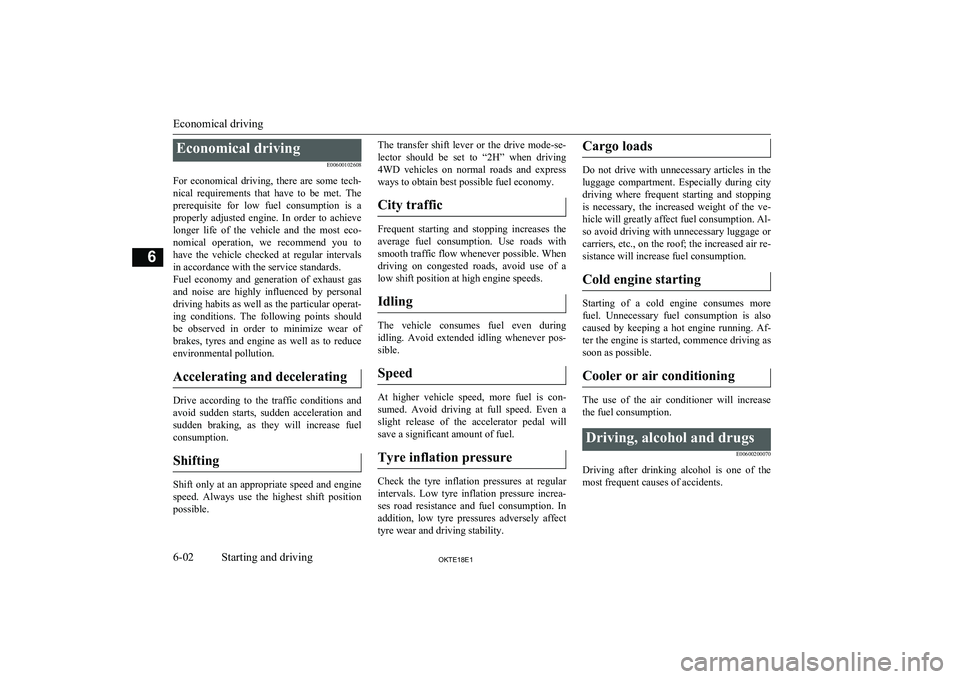
Economical drivingE00600102608
For economical driving, there are some tech- nical requirements that have to be met. Theprerequisite for low fuel consumption is a
properly adjusted engine. In order to achieve longer life of the vehicle and the most eco- nomical operation, we recommend you tohave the vehicle checked at regular intervals in accordance with the service standards.
Fuel economy and generation of exhaust gas
and noise are highly influenced by personal
driving habits as well as the particular operat- ing conditions. The following points shouldbe observed in order to minimize wear of
brakes, tyres and engine as well as to reduce
environmental pollution.
Accelerating and decelerating
Drive according to the traffic conditions andavoid sudden starts, sudden acceleration and
sudden braking, as they will increase fuel
consumption.
Shifting
Shift only at an appropriate speed and engine speed. Always use the highest shift position
possible.
The transfer shift lever or the drive mode-se-
lector should be set to “2H” when driving 4WD vehicles on normal roads and express
ways to obtain best possible fuel economy.
City traffic
Frequent starting and stopping increases the
average fuel consumption. Use roads with smooth traffic flow whenever possible. When driving on congested roads, avoid use of a
low shift position at high engine speeds.
Idling
The vehicle consumes fuel even during idling. Avoid extended idling whenever pos-
sible.
Speed
At higher vehicle speed, more fuel is con-
sumed. Avoid driving at full speed. Even a slight release of the accelerator pedal willsave a significant amount of fuel.
Tyre inflation pressure
Check the tyre inflation pressures at regular intervals. Low tyre inflation pressure increa-ses road resistance and fuel consumption. In addition, low tyre pressures adversely affect
tyre wear and driving stability.
Cargo loads
Do not drive with unnecessary articles in the
luggage compartment. Especially during city
driving where frequent starting and stopping is necessary, the increased weight of the ve-
hicle will greatly affect fuel consumption. Al- so avoid driving with unnecessary luggage or carriers, etc., on the roof; the increased air re- sistance will increase fuel consumption.
Cold engine starting
Starting of a cold engine consumes more fuel. Unnecessary fuel consumption is alsocaused by keeping a hot engine running. Af-
ter the engine is started, commence driving as soon as possible.
Cooler or air conditioning
The use of the air conditioner will increase the fuel consumption.
Driving, alcohol and drugs
E00600200070
Driving after drinking alcohol is one of the
most frequent causes of accidents.
Economical driving
6-02OKTE18E1Starting and driving6
Page 170 of 466
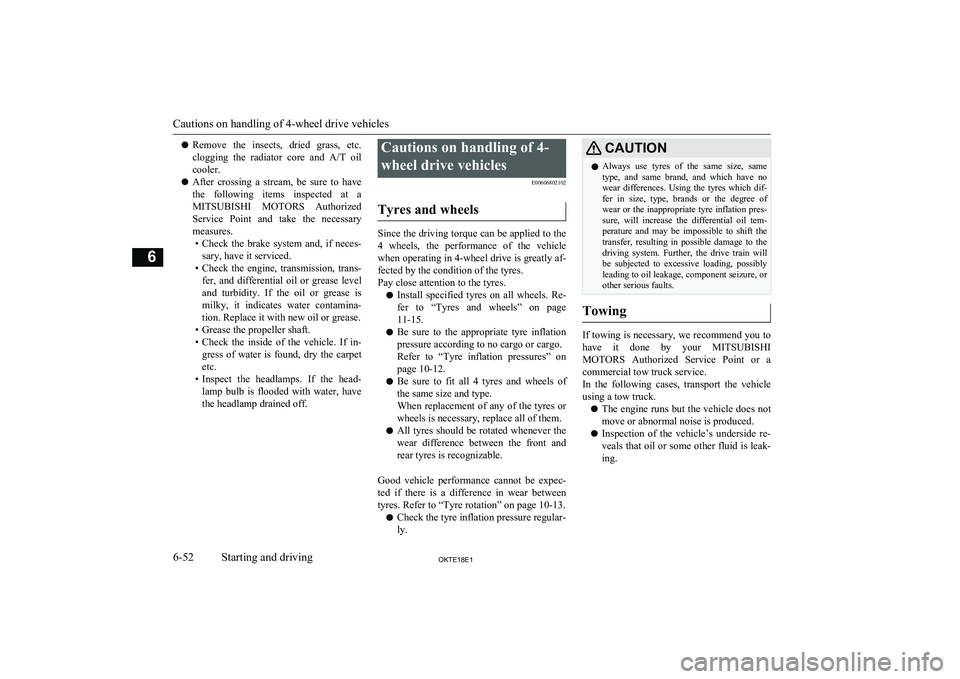
lRemove the insects, dried grass, etc.
clogging the radiator core and A/T oil
cooler.
l After crossing a stream, be sure to have
the following items inspected at a MITSUBISHI MOTORS Authorized
Service Point and take the necessary
measures. • Check the brake system and, if neces-
sary, have it serviced.
• Check the engine, transmission, trans-
fer, and differential oil or grease level and turbidity. If the oil or grease is
milky, it indicates water contamina-
tion. Replace it with new oil or grease.
• Grease the propeller shaft.
• Check the inside of the vehicle. If in-
gress of water is found, dry the carpetetc.
• Inspect the headlamps. If the head-
lamp bulb is flooded with water, have
the headlamp drained off.Cautions on handling of 4-
wheel drive vehicles E00606802102
Tyres and wheels
Since the driving torque can be applied to the 4 wheels, the performance of the vehiclewhen operating in 4-wheel drive is greatly af-
fected by the condition of the tyres.
Pay close attention to the tyres.
l Install specified tyres on all wheels. Re-
fer to “Tyres and wheels” on page 11-15.
l Be sure to the appropriate tyre inflation
pressure according to no cargo or cargo.
Refer to “Tyre inflation pressures” on
page 10-12.
l Be sure to fit all 4 tyres and wheels of
the same size and type.
When replacement of any of the tyres or wheels is necessary, replace all of them.
l All tyres should be rotated whenever the
wear difference between the front and
rear tyres is recognizable.
Good vehicle performance cannot be expec-
ted if there is a difference in wear between tyres. Refer to “Tyre rotation” on page 10-13.
l Check the tyre inflation pressure regular-
ly.
CAUTIONl Always use tyres of the same size, same
type, and same brand, and which have no wear differences. Using the tyres which dif-
fer in size, type, brands or the degree of wear or the inappropriate tyre inflation pres-
sure, will increase the differential oil tem- perature and may be impossible to shift the transfer, resulting in possible damage to the
driving system. Further, the drive train will be subjected to excessive loading, possibly
leading to oil leakage, component seizure, or
other serious faults.
Towing
If towing is necessary, we recommend you to
have it done by your MITSUBISHI
MOTORS Authorized Service Point or a
commercial tow truck service.
In the following cases, transport the vehicle
using a tow truck.
l The engine runs but the vehicle does not
move or abnormal noise is produced.
l Inspection of the vehicle’s underside re-
veals that oil or some other fluid is leak- ing.
Cautions on handling of 4-wheel drive vehicles
6-52OKTE18E1Starting and driving6
Page 203 of 466
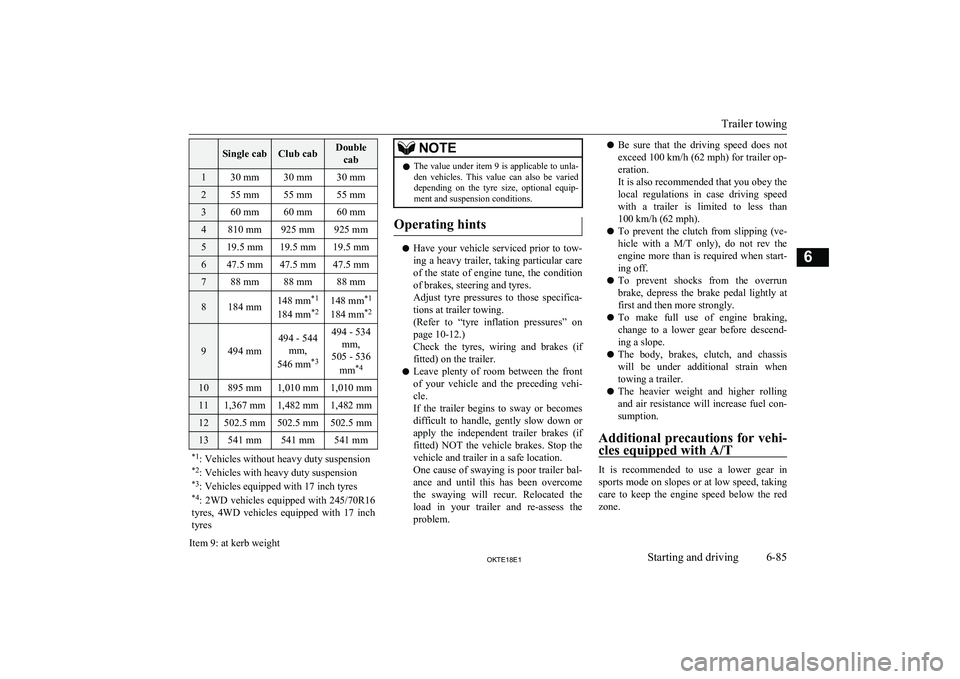
Single cabClub cabDoublecab130 mm30 mm30 mm255 mm55 mm55 mm360 mm60 mm60 mm4810 mm925 mm925 mm519.5 mm19.5 mm19.5 mm647.5 mm47.5 mm47.5 mm788 mm88 mm88 mm8184 mm148 mm *1
184 mm *2148 mm *1
184 mm *2
9494 mm
494 - 544
mm,
546 mm *3494 - 534
mm,
505 - 536
mm *410895 mm1,010 mm1,010 mm111,367 mm1,482 mm1,482 mm12502.5 mm502.5 mm502.5 mm13541 mm541 mm541 mm*1
: Vehicles without heavy duty suspension
*2 : Vehicles with heavy duty suspension
*3 : Vehicles equipped with 17 inch tyres
*4 : 2WD vehicles equipped with 245/70R16
tyres, 4WD vehicles equipped with 17 inch
tyres
Item 9: at kerb weight
NOTEl The value under item 9 is applicable to unla-
den vehicles. This value can also be varied depending on the tyre size, optional equip-
ment and suspension conditions.
Operating hints
l Have your vehicle serviced prior to tow-
ing a heavy trailer, taking particular care
of the state of engine tune, the condition of brakes, steering and tyres.
Adjust tyre pressures to those specifica- tions at trailer towing.
(Refer to “tyre inflation pressures” on
page 10-12.)
Check the tyres, wiring and brakes (if fitted) on the trailer.
l Leave plenty of room between the front
of your vehicle and the preceding vehi- cle.
If the trailer begins to sway or becomes difficult to handle, gently slow down or
apply the independent trailer brakes (if fitted) NOT the vehicle brakes. Stop the
vehicle and trailer in a safe location.
One cause of swaying is poor trailer bal-
ance and until this has been overcome the swaying will recur. Relocated the load in your trailer and re-assess the problem.
l Be sure that the driving speed does not
exceed 100 km/h (62 mph) for trailer op-
eration.
It is also recommended that you obey the
local regulations in case driving speed with a trailer is limited to less than
100 km/h (62 mph).
l To prevent the clutch from slipping (ve-
hicle with a M/T only), do not rev the
engine more than is required when start-
ing off.
l To prevent shocks from the overrun
brake, depress the brake pedal lightly at
first and then more strongly.
l To make full use of engine braking,
change to a lower gear before descend-
ing a slope.
l The body, brakes, clutch, and chassis
will be under additional strain when
towing a trailer.
l The heavier weight and higher rolling
and air resistance will increase fuel con- sumption.
Additional precautions for vehi-
cles equipped with A/T
It is recommended to use a lower gear in
sports mode on slopes or at low speed, taking care to keep the engine speed below the red
zone.
Trailer towing
6-85OKTE18E1Starting and driving6
Page 331 of 466
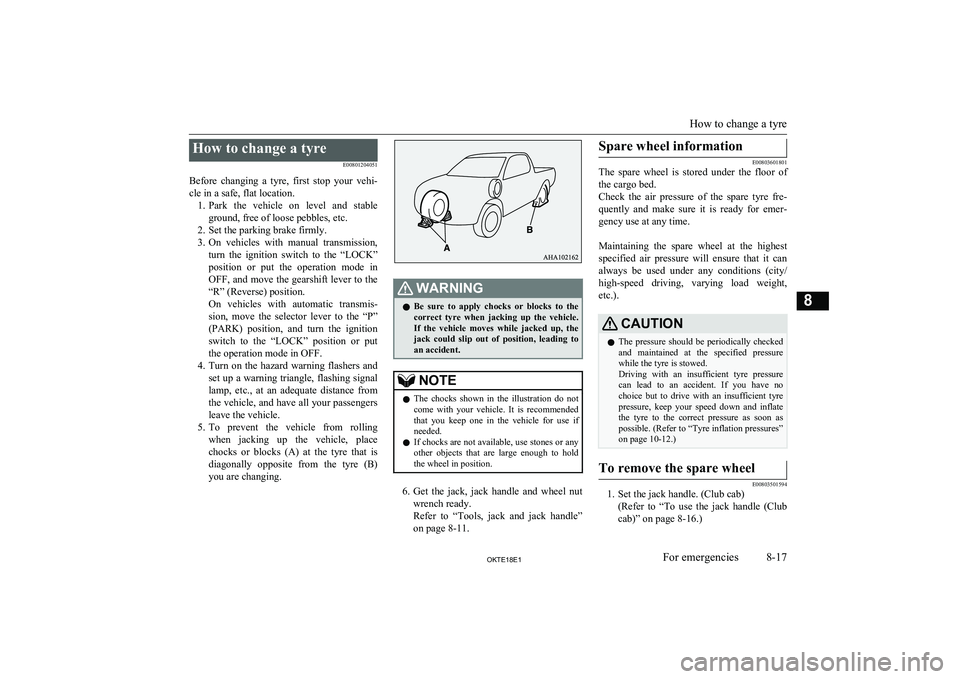
How to change a tyreE00801204051
Before changing a tyre, first stop your vehi- cle in a safe, flat location. 1. Park the vehicle on level and stable
ground, free of loose pebbles, etc.
2. Set the parking brake firmly.
3. On vehicles with manual transmission,
turn the ignition switch to the “LOCK”
position or put the operation mode in
OFF, and move the gearshift lever to the
“R” (Reverse) position.
On vehicles with automatic transmis- sion, move the selector lever to the “P” (PARK) position, and turn the ignitionswitch to the “LOCK” position or put
the operation mode in OFF.
4. Turn on the hazard warning flashers and
set up a warning triangle, flashing signal
lamp, etc., at an adequate distance from
the vehicle, and have all your passengers
leave the vehicle.
5. To prevent the vehicle from rolling
when jacking up the vehicle, placechocks or blocks (A) at the tyre that is
diagonally opposite from the tyre (B)
you are changing.WARNINGl Be sure to apply chocks or blocks to the
correct tyre when jacking up the vehicle.If the vehicle moves while jacked up, the
jack could slip out of position, leading to
an accident.NOTEl The chocks shown in the illustration do not
come with your vehicle. It is recommended
that you keep one in the vehicle for use if needed.
l If chocks are not available, use stones or any
other objects that are large enough to hold the wheel in position.
6. Get the jack, jack handle and wheel nut
wrench ready.
Refer to “Tools, jack and jack handle” on page 8-11.
Spare wheel information
E00803601801
The spare wheel is stored under the floor of
the cargo bed.
Check the air pressure of the spare tyre fre-
quently and make sure it is ready for emer- gency use at any time.
Maintaining the spare wheel at the highest
specified air pressure will ensure that it can always be used under any conditions (city/ high-speed driving, varying load weight,
etc.).
CAUTIONl The pressure should be periodically checked
and maintained at the specified pressure while the tyre is stowed.
Driving with an insufficient tyre pressure
can lead to an accident. If you have no choice but to drive with an insufficient tyre
pressure, keep your speed down and inflate the tyre to the correct pressure as soon as
possible. (Refer to “Tyre inflation pressures”
on page 10-12.)To remove the spare wheel
E00803501594
1. Set the jack handle. (Club cab)
(Refer to “To use the jack handle (Clubcab)” on page 8-16.)
How to change a tyre
8-17OKTE18E1For emergencies8
Page 336 of 466
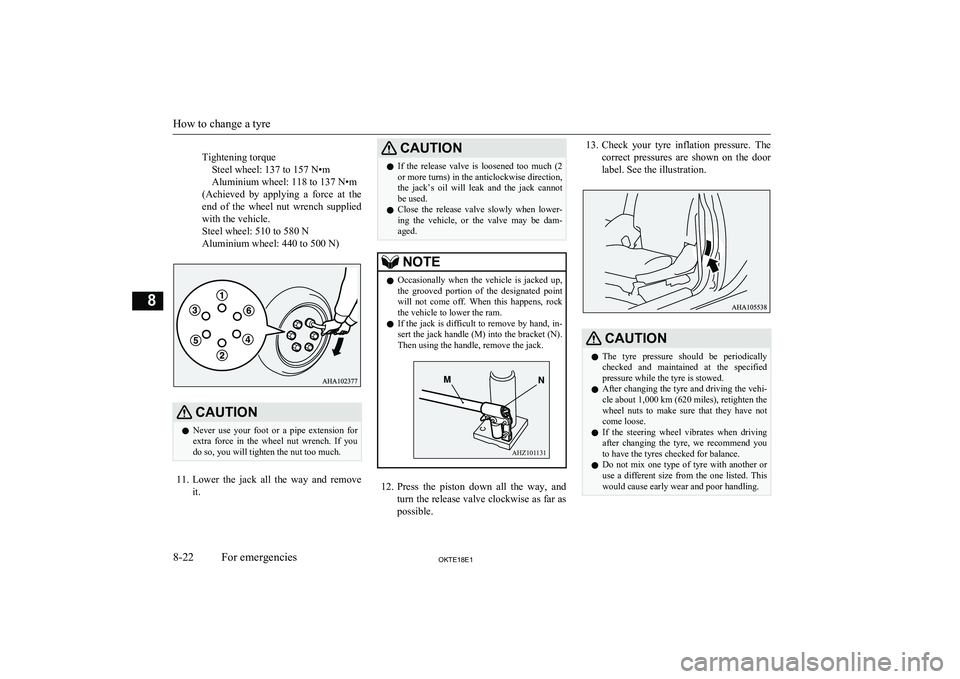
Tightening torqueSteel wheel: 137 to 157 N•m
Aluminium wheel: 118 to 137 N•m
(Achieved by applying a force at the end of the wheel nut wrench supplied
with the vehicle.
Steel wheel: 510 to 580 N
Aluminium wheel: 440 to 500 N)CAUTIONl Never use your foot or a pipe extension for
extra force in the wheel nut wrench. If you
do so, you will tighten the nut too much.
11. Lower the jack all the way and remove
it.
CAUTIONl If the release valve is loosened too much (2
or more turns) in the anticlockwise direction, the jack’s oil will leak and the jack cannot
be used.
l Close the release valve slowly when lower-
ing the vehicle, or the valve may be dam-
aged.NOTEl Occasionally when the vehicle is jacked up,
the grooved portion of the designated pointwill not come off. When this happens, rock
the vehicle to lower the ram.
l If the jack is difficult to remove by hand, in-
sert the jack handle (M) into the bracket (N).
Then using the handle, remove the jack.
12. Press the piston down all the way, and
turn the release valve clockwise as far as possible.
13. Check your tyre inflation pressure. The
correct pressures are shown on the door
label. See the illustration.CAUTIONl The tyre pressure should be periodically
checked and maintained at the specified pressure while the tyre is stowed.
l After changing the tyre and driving the vehi-
cle about 1,000 km (620 miles), retighten the
wheel nuts to make sure that they have not come loose.
l If the steering wheel vibrates when driving
after changing the tyre, we recommend you to have the tyres checked for balance.
l Do not mix one type of tyre with another or
use a different size from the one listed. This
would cause early wear and poor handling.
How to change a tyre
8-22OKTE18E1For emergencies8 AHZ101131
Page 342 of 466
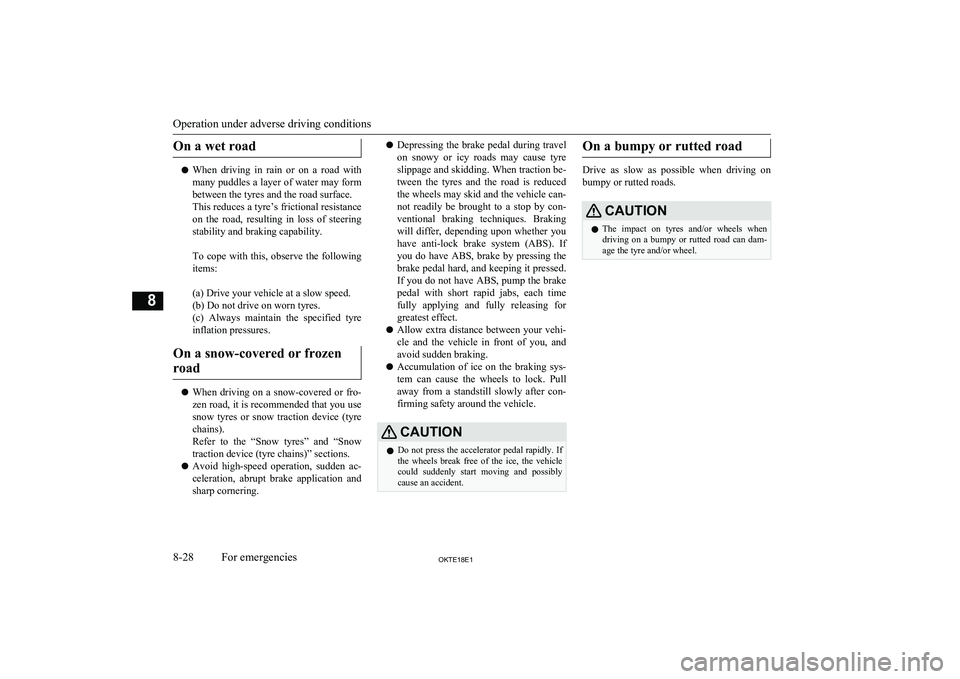
On a wet road
lWhen driving in rain or on a road with
many puddles a layer of water may form
between the tyres and the road surface.
This reduces a tyre’s frictional resistance on the road, resulting in loss of steering stability and braking capability.
To cope with this, observe the following
items:
(a) Drive your vehicle at a slow speed. (b) Do not drive on worn tyres. (c) Always maintain the specified tyre inflation pressures.
On a snow-covered or frozen road
l When driving on a snow-covered or fro-
zen road, it is recommended that you use
snow tyres or snow traction device (tyre chains).
Refer to the “Snow tyres” and “Snow
traction device (tyre chains)” sections.
l Avoid high-speed operation, sudden ac-
celeration, abrupt brake application and
sharp cornering.
l Depressing the brake pedal during travel
on snowy or icy roads may cause tyre
slippage and skidding. When traction be-
tween the tyres and the road is reduced
the wheels may skid and the vehicle can- not readily be brought to a stop by con-
ventional braking techniques. Braking will differ, depending upon whether you have anti-lock brake system (ABS). Ifyou do have ABS, brake by pressing the
brake pedal hard, and keeping it pressed. If you do not have ABS, pump the brake
pedal with short rapid jabs, each time
fully applying and fully releasing for
greatest effect.
l Allow extra distance between your vehi-
cle and the vehicle in front of you, and avoid sudden braking.
l Accumulation of ice on the braking sys-
tem can cause the wheels to lock. Pull
away from a standstill slowly after con- firming safety around the vehicle.CAUTIONl Do not press the accelerator pedal rapidly. If
the wheels break free of the ice, the vehicle
could suddenly start moving and possibly
cause an accident.On a bumpy or rutted road
Drive as slow as possible when driving on
bumpy or rutted roads.
CAUTIONl The impact on tyres and/or wheels when
driving on a bumpy or rutted road can dam-
age the tyre and/or wheel.
Operation under adverse driving conditions
8-28OKTE18E1For emergencies8